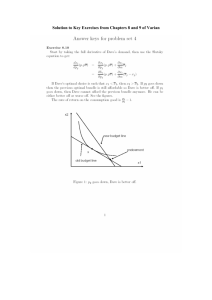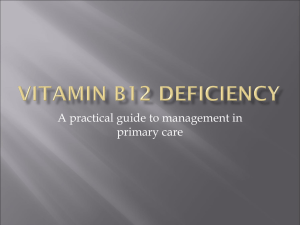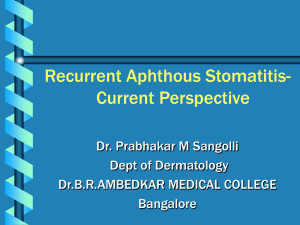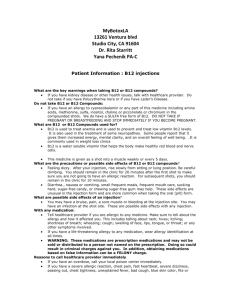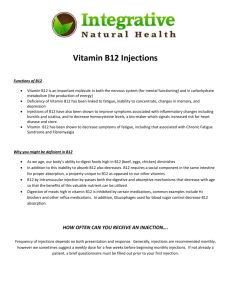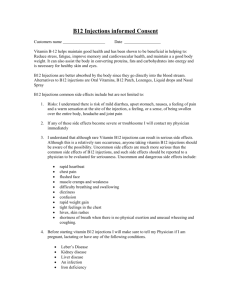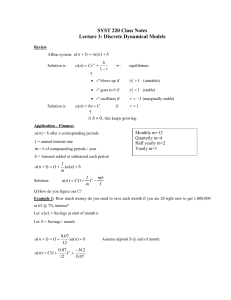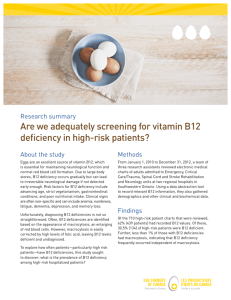Tuesday_8_AAllen_Ross_Sea_2014_ICESOCCS
advertisement
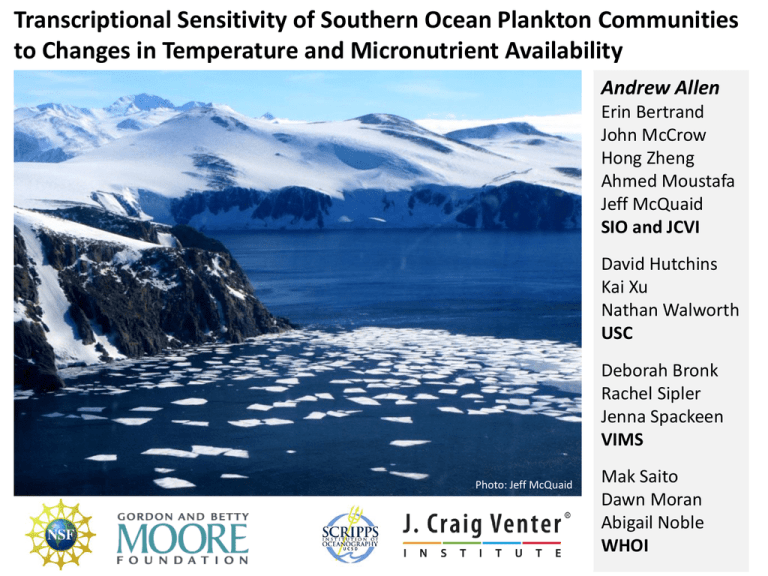
Transcriptional Sensitivity of Southern Ocean Plankton Communities to Changes in Temperature and Micronutrient Availability Andrew Allen Erin Bertrand John McCrow Hong Zheng Ahmed Moustafa Jeff McQuaid SIO and JCVI David Hutchins Kai Xu Nathan Walworth USC Deborah Bronk Rachel Sipler Jenna Spackeen VIMS Photo: Jeff McQuaid Mak Saito Dawn Moran Abigail Noble WHOI Change and Projected Change in the Ross Sea Sea Surface Temperature: • Slight negative SST trend over past ~20-30 years; expected to continue 2-3 decades (Mayewski et al 2009, Comiso et al 2000, Lebedev 2007) • Then expected to warm substantially by the end of the next century (Bracegirdle and Stephenson, 2012); specific projections difficult (Smith et al 2014) Iron: • Relative magnitude of sources still unclear • Shelf sediments, dust, sea ice • Result: change is likely but difficult to predict- direction and magnitude (Smith et al 2012, 2014) Change is coming: understand diversity and transcriptional baselines, response of existing communities Photos: Jeff McQuaid, Dawn Moran Ice Jan 18S rRNA analysis of Spring and Summer water column and sea ice McMurdo Sound communities Nov Alveolata Haptophyta Cryptophyta Chlorophyta 10% 1% 0.1% Opisthokonta Diatoms Dawn Moran, Jeff McQuaid, Greg Wanger Saito Lab, WHOI Ahmed Moustafa, JCVI, AUC Egypt Ice Jan CFB Nov 16S rRNA analysis of Spring and Summer water column McMurdo Sound communities Alphaproteobacteria 2 µm Sea Ice diatom and bacteria (Greg Wanger) Gammaproteobacteria Saito Lab, WHOI Ahmed Moustafa, JCVI, AUC Egypt Question: What is the transcriptional response of McMurdo Sound phytoplankton and bacterial communities to changes in temperature, iron, and vitamin B12 availability? Approach: Manipulative experiments, late summer McMurdo Sound of the Ross Sea, Jan 2013 Photos: Erin Bertrand, Jeff McQuaid McMurdo Sound of the Ross Sea, late austral summer 2012/13 Ross Island MODIS 16 Jan 2013: Collect 1000 L trace metal clean seawater; return via helicopter to McMurdo Station, Crary Lab Three types of manipulative experiments • Short term batch- manipulate Fe, B12 • Semicontinuous dilution- manipulate temperature, Fe • Continuous flow- “ecostats”- manipulate temperature, Fe, CO2 Fe and B12 Dynamics in the Ross Sea 2 of 4 previous bottle experiments in the Ross Sea showed B12 limitation of phytoplankton growth • secondary to Fe limitation Function of initial community composition? • Bacterial abundance • Phytoplankton community MetE MetH Summer Spring MetE Bertrand et al 2007, 2011 Cyanobacteria MetE MetE MetH B12 MetH MetH Eukaryotic phytoplankton MetH Heterotrophic bacteria and archaea Photodegradation Short term bioassays: B12 and iron Characterize transcriptional response of initial community to micronutrient additions at 0°C • 1 nM FeCl3, 200 pM B12 Control +B12 Incubate 0°C, 24h • RNA samples • Nitrate, bicarbonate uptake (Bronk Lab) • Chla measure After 96h, Chla measure +Fe Harvest trace metal clean seawater, return to Crary Lab Photos: Jen Erxleben +B12Fe Fill 2.7 L bottles and supplement Bertrand et al in prep 1.6 0h 24 h -1 Chl a (g L ) 1.4 96 h * * * 1.2 1.0 0.8 Chlorophyll a at 96h: community was independently B12 and Fe limited 0.6 0.4 0.2 Cont +Fe +B12 +B12Fe 0.0012 0.0010 * 0.0008 * 0.0006 0.0004 At 24h: Nitrate uptake rate increased in +Fe treatments No change in chlorophyll a or primary productivity 0.0002 0.0000 0.20 -1 -1 HCO3 (mol C L h ) -1 -1 NO3 (mol N L h ) 0.0 0.0014 Sequence community RNA after 24 hours rRNA removal to enrich mRNA target bacteria and phytoplankton 0.15 0.10 0.05 0.00 t=0 Cont +Fe +B12 +B12Fe Bertrand et al in prep Metatranscriptome analysis pipeline Sample collection 200-2000 mL filtered onto 0.2 um cartridge filters RNA extraction Library prep Sequencing and cleanup plus rRNA removal NuGen cDNA synthesis and Truseq library preparation Paired end Illumina Hiseq 2000 Targets Bacteria, Archaea, Eukaryotic nuclear and organelle mRNA Read Filtering Filtering of primers, adapters, rRNA; quality trimming Assembly Combined assembly by merging in stages (CLC de novo) ORF Calling Prediction of ORFs on assembled contigs and further filtering of rRNA PhyloDB: • 25 million peptide sequences • Does not rely on blast hit for functional annotation • MMETSP transcriptome sequencing included PhyloDB Annotation (1)Taxonomy via best blast hit (2) functional domains (PFams/TIGRFams), KEGG, KOG, GO, EC, pathway, transporter and transmembrane domains, organelle assignment Sequencing and Assembly Summary Pooled libraries Raw Trimmed Mapped rRNA Assigned Eukaryotes Bacteria Archaea Virus Unknown phylogeny % rRNA, % mapped 100 Percent of trimmed reads 441,425,648 414,698,752 299,185,770 21,624,539 171,783,433 141,024,961 28,424,075 214,737 954,416 1,165,244 ORFS 194,173 136,144 56,031 245 1096 657 Assigned Reads: 82% eukaryotic 16% bacterial % mapped % rRNA % spike 80 1.0 0.8 60 0.6 40 0.4 20 0.2 0 0.0 Co n tA Co n tB Co n tC F eA F eB C 2 A 12 B 12 C Fe A Fe B Fe C Fe 2 B1 B B 2 2 B1 B1 B1 % spike 1 Reads Community contributions to mRNA pool Eukaryotes Bacteria and Archaea Metazoa Control +Fe +B12 Fungi +B12Fe Other Eukayotes A. Control +Fe +B12 Archaea Other Bacteria B. +B12Fe Betaproteobacteria Haptophyta Gammaproteobacteria Cryptophyta Alphaproteobacteria Streptophyta Firmicutes Chlorophyta Cyanobacteria Dinophyta Bacteroidetes/Chlorobi Ciliophora Actinobacteria Other Stramenopiles 0 Pelagophyte 10 20 30 40 50 % of reads assigned to bacteria and archaea Centric Diatom Pennate Diatom 0 10 20 30 40 50 % of reads assigned to eukaryotes Error bars: 1SD, triplicates 60 Transcriptome differences reflect changes in gene expression levels within the community, NOT community composition changes 60 Community contributions to mRNA pool Eukaryotes Diatoms Metazoa Control +Fe +B12 Fungi +B12Fe Other Eukayotes A. other centric Control +Fe +B12 Coscinodiscophyceae +B12Fe C. Thalassiosira Haptophyta Cryptophyta Chaetoceros Streptophyta other pennate Chlorophyta Pseudo-nitzchia Dinophyta Fragilariopsis Ciliophora Other Stramenopiles 0 Pelagophyte 10 20 30 40 50 % of diatom reads assigned Centric Diatom Pennate Diatom 0 10 20 30 40 50 % of reads assigned to eukaryotes Error bars: 1SD, triplicates 60 Fragilariopsis- dominated diatom community, no significant differences: changes reflect transcriptome responses to micronutrients, not community composition changes 60 Transcriptional changes induced by micronutrient additions Bacteroidetes/Chlorobi Cont vs Fe B12 vs B12 Fe Cont vs B12 Bacteroidetes/Chlorobi Fe vs B12Fe Gammaproteobacteria Gammaproteobacteria Alphaproteobacteria Alphaproteobacteria Dinophyta Dinophyta Centric diatoms Centric diatoms Pennate diatoms Pennate diatoms 0.0 0.2 0.4 0.6 0.8 1.0 1.2 Percentage of differentially expressed ORFs (FDR< 0.05) 0.0 0.5 1.0 1.5 2.0 2.5 Percentage of reads mapped to diff. expressed ORFs (FDR< 0.05) Differentially expressed: edgeR pairwise comparisons of triplicate treatments, FDR < 0.05 B12 exhibits strong influence on short term transcriptional response across all three most abundant groups per kingdom fmol CBA1 per g total protein Hypothesized B12- starvation biomarkers from culture work: fmol MetE per g total protein Diatom responses to changes in B12 availability 4 High B12 MetE Low B12 3 2 1 0 10 CBA1 8 6 4 Figure: Amy Caracappa-Qubeck, WHOI 2 0 + B12 - B12 MetE and CBA1 protein in P. tricornutum cultures (Bertrand et al L and O, 2013) MetE and CBA1 (Bertrand et al 2012, 2013) Diatom responses to changes in B12 availability log2(treatment/control) 10 5 Fe/control B12/control B12Fe/control MetE High B12 Low B12 0 -5 -10 Figure: Amy Caracappa-Qubeck, WHOI log2(treatment/control) 6 4 2 0 -2 -4 Fe/control B12/control B12Fe/Fe CBA1 MetE and CBA1: repressed by B12 and not driven by iron- confirmed as biomarkers for B12 starvation -6 Showing three log 2 fold change values for each ORF annotated as diatom MetE, CBA1 with >50 total reads mapped Behavior of known Fe- responsive transcripts log2(treatment/control) 4 Fe/control B12/control Flavodoxin, clade 2 2 0 -2 -4 log2(treatment/control) 4 Fe/control B12/control ISIP2A 2 0 -2 -4 12% of flavodoxin c2 ORFs , 16% of ISIP2A ORFS with > 500 reads assigned: down-regulated (FDR <0.05) by Fe addition Dominated by phyla we expect for the season Bacteria and Archaea (Ghiglione and Murray 2012; Williams et al 2012; Williams et al 2013; Grzymski et al 2012; Brown et al 2012) Control +Fe +B12 Archaea Other Bacteria B. Bacteroidetes: 53% of reads best hit to 4 genomes +B12Fe Polaribacter Betaproteobacteria Aequorivita Gammaproteobacteria Ulvibacter sp. SCB49 Alphaproteobacteria Other CFB Firmicutes Cyanobacteria Bacteroidetes/Chlorobi Actinobacteria Gammaproteobacteria: 52% of reads best hit 0 10 20 30 40 50 % of reads assigned to bacteria and archaea Alphaproteobacteria: 42% of reads best hit to 10 genomes 60 to 7 genomes SAR 92 other Alteromonadales Neptinibacter other Oceanospirillales OMG Methylophaga other gamma SAR11 Rhodobactereaceae uncultured marine alphas other alpahs Clear documentation of B12- starvation and Fe limitation in diatoms… B12 sources, Fe demand in bacteria? Uroporphyrinogen-III cysG Precorrin 2 Heme and Chla synthesis cbiX (Cobalt) Precorrin 2 Transcripts from each enzyme in B12 biosynthesis pathway detected cobI/cbiL (Cobalt) Precorrin 3 ORFs detected (≥1) with best blast hits to: cobGJ/cbiHG Gammaproteobacteria Alphaproteobacteria (Cobalt) Precorrin 4 Bacteroidetes cobM/cbiF (Cobalt) Precorrin 5 ORFs B12-repressed (FDR≤0.1) cobF/cbiD Cob(II)yrinic acid a,c diamide (Cobalt) Precorrin 6x cobK/cbiJ reductase Cob(I)yrinic acid a,c diamide (Cobalt) Precorrin 6y cobO/btuR cobL/cbiET Adenosylcobyrinic acid a,c diamide (Cobalt) Precorrin 8x Transport and uptake btuB btuF cobQ/cbiP cobH/cbiC cobC/D Aminopropanol-2P Hydrogenobyrinic acid/Cobyrinic acid Adenosylcobyrinic acid cobD/cbiB Cobinamide cobB/cbiA Hydrogenobyrinic acid a,c diamide cobNST DMB + NHN cobT α-ribazole 5P cobC α-ribazole Adenosylcobinamide btuR cobU/cobP Adenosyl-GDP-cobinamide Cobyrinic acid cobS btuR Pathway modified from Rovionov et al 2003 Cobalamin Adenosylcobalamin Control +Fe +B12 +B12Fe Up Down Iron- induced Differentially expressed Gammaproteobacterial transcripts differentially expressed: edgeR pairwise comparisons between any treatments FDR< 0.05 MeV hierarchical clustering: genes Key Iron Induced transcripts • Multiple Bacterioferritins • Recombinases • Sigma factors and kinases Regulated Fe uptake and storage responses: signs of Fe-limitation Key Iron repressed transcripts • Multiple TonB-dependent iron complex, Fe3+ dicitrate receptor domains Iron- repressed Control +Fe +B12 +B12Fe Up Down Differentially expressed Gammaproteobacterial transcripts differentially expressed: edgeR pairwise comparisons between any treatments FDR< 0.05 MeV hierarchical clustering: genes B12- /B12Fe induced B12- repressed Key B12 / B12Fe Induced: • RNA polymerase • multiple pilA • Chaperonins • outer membrane proteins Key B12 repressed: • B12- transporters and binding domains • B12- biosynthesis proteins • B12-dependant RNR Regulated B12 uptake, production, and use Bacterial group possibly responsible for B12- production: signs of Fe- limitation Gammaproteobacteria Key Iron repressed: Multiple TonB-dependent iron complex, Fe3+ dicitrate receptor domains Ross Sea Springtime Bacterial growth independently Fe-limited (Bertrand et al 2011) MetE MetH MetE MetE Molecular evidence for multiple layers of micronutrient interactions and starvation Key B12 repressed: • B12- transporters and binding domains • B12- biosynthesis proteins • B12-dependant RNR Cyanobacteria MetE B12 MetH MetH Eukaryotic MetHphytoplankton MetH Heterotrophic bacteria and archaea Photodegradation McMurdo Sound of the Ross Sea, late austral summer 2012/13 Ross Island MODIS 16 Jan 2013: Collect 1000 L trace metal clean seawater; return via helicopter to McMurdo Station, Crary Lab Three types of manipulative experiments • Short term batch- manipulate Fe, B12 • Semicontinuous dilution- manipulate temperature, Fe • Continuous flow- “ecostats”- manipulate temperature, Fe, CO2 McMurdo Sound Semicontinuous Experiment 20 0 C cont 0 C +Fe 4 C cont 4 C +Fe Chl a (g/L) 15 Iron: +/- I nM Fe Temperature: 4°C or 0°C Triplicates, outdoor incubation at 15% of ambient light t=0 same as short term Fe and B12 addition experiment 10 5 0 2 4 Micronutrient nutritional status and interaction changes 8 Dilute at arrows (1:6 to 1:2) Sequence transcriptomes Short term B12 and Fe experiment (t = 0) Transcriptomes to assess: • Identity and physiology of major groups responding favorably to temperature increase • 6 10 12 14 16 18 Days Temperature and Iron: strong drivers of phytoplankton growth McMurdo Sound Semicontinuous Experiment: Community mRNA contributions % assigned reads 80 t=0 0C, low Fe 0C, high Fe 4C, low Fe 4C, high Fe 60 40 20 0 s se u r Vi h Arc a ae ia te r c Ba o y r a k Eu n s e t a cle t r u C r hlo o s a l p h ti oc M a o ri d n High temperature: Eukaryotes make a larger contribution to mRNA pool at the expense of Bacteria t = 0: all 12 libraries from short term experiment Diatom gene expression shifts % ORFs Significantly Different (FDR < 0.05) 50 4C -Fe vs 0C -Fe 4C +Fe vs 0C +Fe +Fe 0C vs -Fe 0C +Fe 4C vs -Fe 4C 40 30 20 10 0 tz Pse ros chia z /Nit a i h c - ni udo Ch ce aeto ario agil psis Fr EdgeR pairwise comparisons; triplicate treatments • Temperature has a larger influence than Fe on Pseudo-nitzchia and Chaetoceros gene expression • Iron is a more important factor for Fragilariopsis gene expression than the other diatoms • Suggests different sensitivities/ capabilities for handling change Fragilariopsis responses to variability in iron 0 -Fe 0 +Fe 4 -Fe 4 +Fe Up Group- normalized Z- scores for top 100 most abundant Fragilariopsis transcripts (nuclear) differentially expressed in high vs low Fe (EdgeR FDR < 0.05) Down SAH-ase, Betaine transporter, Lhc 12, ATP-ases CBA1 High Fe- induced regardless of temperature Plastocyanin* Lhcf 5, 12, histones Flavodoxin* Lhcf 10, 11 High Fe- induced only at high temperature Lhcf 1, 4, 8 Bacteriorhodopsin Cation transporter ISIP2A High Fe- Repressed Diatom B12- starvation indicators Sum Group Normalized Expression Value 10000 8000 0C -Fe 0C +Fe 4C -Fe 4C +Fe 6000 4000 2000 0 CBA1 Centric CBA1 Pennate MetE Centric MetE Pennate High Fe and temperature appear to enhance B12 limitation in diatoms Values estimate expression of each ORFs relative to expression of all ORFs from centric or pennate diatoms EdgeR TMM values, mean of triplicates +/- 1 SD shown. Fluorescence One Pseudo- nitzchia isolate is a confirmed B12 auxotroph 90 80 70 60 50 40 30 20 10 0 10 nM B1 + 0 B12 0 B1 + 100 pM B12 10 nM B1 + 100 pM B12 Mixed community, Arrow: MCM Pseudo-nitzchia Image Credit: Jeff McQuaid 0 2 Preliminary data, post antibiotic treatment, not axenic 4 6 Days 8 10 12 t=0 0C, low Fe 0C, high Fe 4C, low Fe 4C, high Fe Undetermined Fragilariopsis sp. Pseudo-nitzchia dominate at high Fe high temp despite documented B12 limitation • Bacterial partners? • Strain variability? Nitzschia sp. Pseudo-nitzschia sp. Chaetoceros sp. 0 2000 4000 6000 cells mL -1 8000 10000 Summary- McMurdo Sound Incubation Metatranscriptomics Short term B12 and Fe experiment 1.6 0h 24 h -1 Chl a (g L ) 1.4 96 h * • B12 and iron limitation of phytoplankton growth • Confirmation of diatom molecular markers for B12 limitation • Gammaproteobacterial B12 source? • Interactive micronutrient dynamics: Fe limitation of B12 production and use * * 1.2 1.0 0.8 0.6 0.4 0.2 0.0 Cont +Fe +B12 +B12Fe t=0 Cont +Fe +B12 +B12Fe Semicontinuous Fe and Temperature experiment 20 Strong temperature impact on phytoplankton growth, community composition, and gene expression Pseudo-nitzchia • Imbalance in bacterial and phytoplankton response • Implications for future impact of temperature on micronutrient dynamics 0 C cont 0 C +Fe 4 C cont 4 C +Fe 15 Chl a (g/L) • 10 5 0 2 4 6 8 10 Days 12 14 16 18 Towards understanding diversity and transcriptional baselines and sensitivities of Antarctic marine microbial communities - three approaches • Cultures • Manipulative experiments • Surveys • Powerful synergy developing o Future work: further exploration of temperature and micronutrient interactions in co-cultures and manipulative experiments o Better and temporally extended microbial surveys: LR-AUV technology with automated microbial sampling platforms o Influence of temperature on sea ice algae life cycles and viruses o Viruses and domoic acid (DA) producing phytoplankton (HABs)
